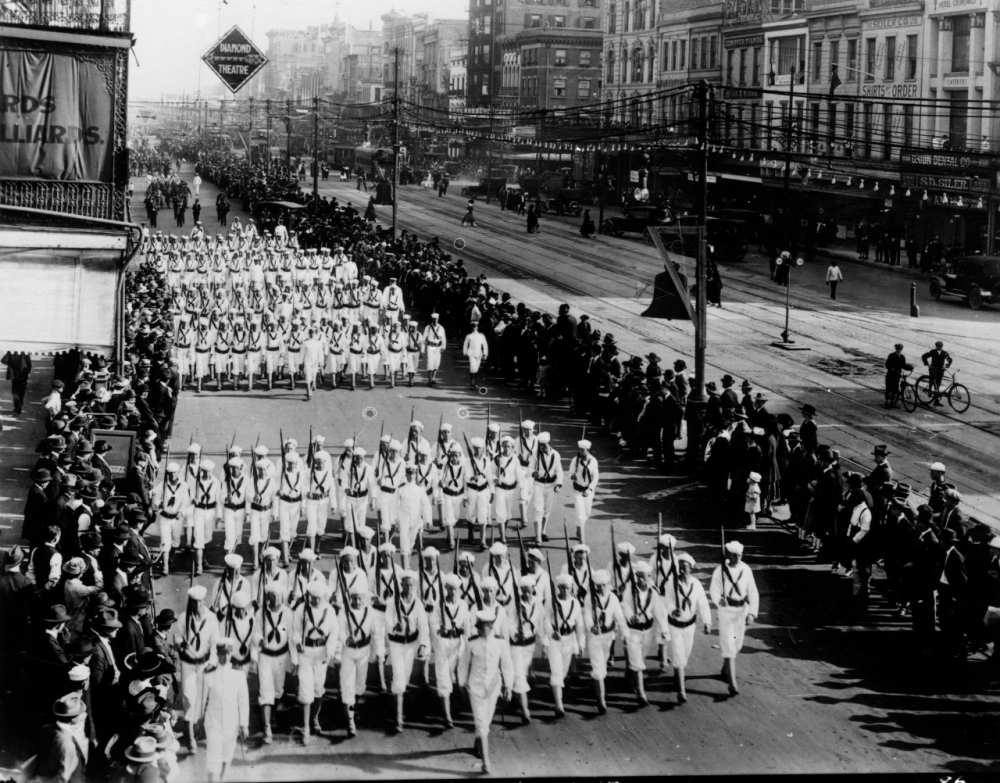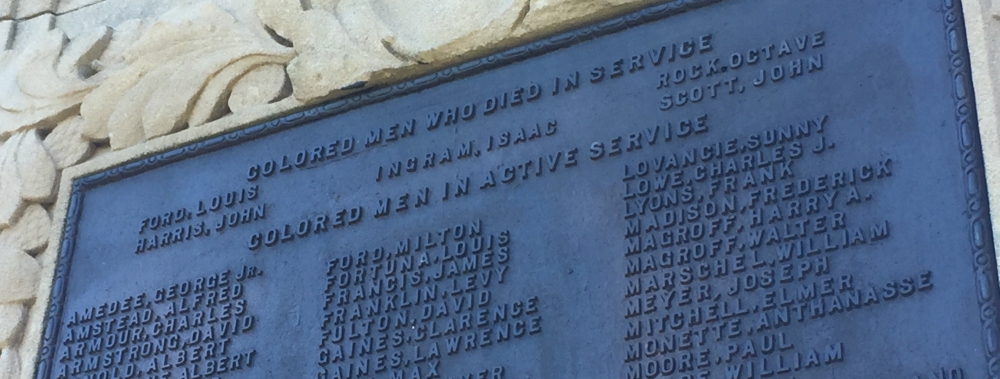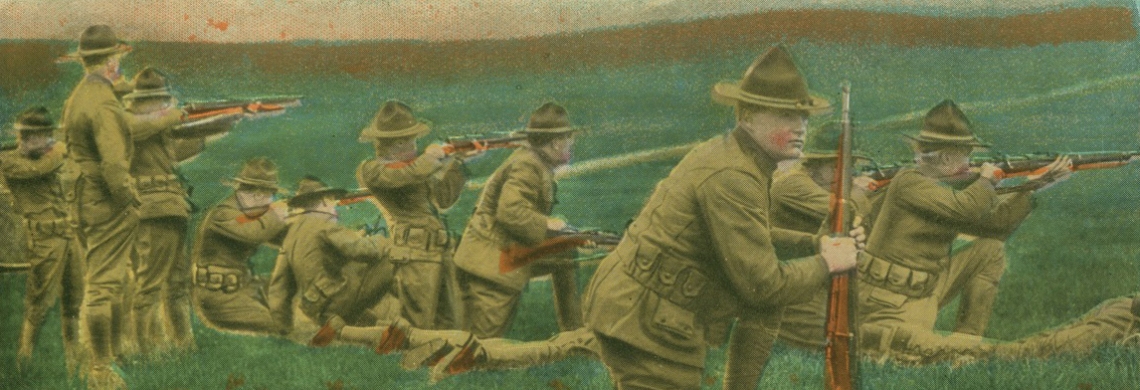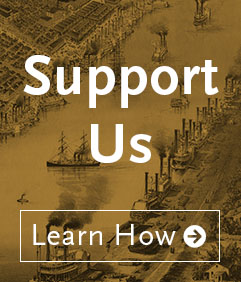One hundred years after fighting in World War I ended on November 11, 1918, THNOC reflects on some of the ways that the war and its aftermath touched the city of New Orleans. From the elimination of the city’s red-light district to unprecedented displays of patriotism, WWI brought significant changes to local ways of life.
1. Sympathy for the allied cause

(Left) A Belgian Relief Cook Book; (right) a postcard sent to Clarisse Claiborne by Louis Lemoine, a Belgian soldier. (THNOC, bequest of Clarisse Claiborne Grima, 81-99-L.6, .12)
World War I started in 1914, but the United States would not enter combat until 1917. While Americans weren’t involved in the fighting at first, their sympathies were deeply engaged. This was especially true in New Orleans, a port city home to recent immigrants as well as longer-settled families of European heritage. Many felt kinship with the French and Belgians and supported their efforts against the German invasion. A benefit for Belgian relief was held at Antoine’s Restaurant in 1914, and throughout the war, local women, like Clarisse Claiborne, exchanged letters with Belgian soldiers on the front.
2. The German Bazaar

(Left) A banner from the German-American Alliance dating to the early 20th century; (right) the Athenaeum, a venue on St. Charles Avenue where the German Bazaar took place in 1915. (THNOC, gift of Deutsches Haus, 2008.0113.8; 1990.51.2.10 ii).
While French was still spoken in many corners of Louisiana, New Orleans also had a large German-speaking community that dated back to the 18th century. German-American organizations across the country raised money for the German Red Cross and led efforts to generate sympathy for their ancestral land. In April 1915, groups in New Orleans put on the German Bazaar, a major public event that drew 5,000 people—including non-Germans as well as Germans. Considered a major success, the event raised $7,000 (about $175,000 today) for the German and Austrian Red Cross and featured various amusements, such as a beer garden, as well as German war films that had never been shown in the United States.
3. The patriotic response

Sailors march in a Liberty Bond parade on Canal Street in 1917. (THNOC, the Charles L. Franck Studio Collection, 1979.325.4084)
When the US entered the war in April of 1917, the military had to quickly mobilize a large force to engage in the massive conflict. This took troops and money, and New Orleans contributed both. Liberty Bond parades resembled the largest Mardi Gras celebrations, and the city exceeded its bond quota on every drive. By the end of the war, united in allegiance to the American cause, New Orleanians of all ancestries celebrated victory together.
4. The xenophobic reaction

Cracked sidewalk tiles denoting Berlin Street are all that remain at the modern-day intersection of General Pershing and Laurel Streets.
 Just two years after the city—including the mayor and many local businesses—supported the massive German Bazaar, public sentiment lurched toward the allied cause. Patriotic propaganda with anti-German strains became prevalent as the United States entered the war, with images depicting Germans as sub-human featured on advertising posters for bond drives and recruitment (such as in the poster shown on the right). In New Orleans, Berlin Street in the Faubourg Bouligny neighborhood was renamed General Pershing Street, after the American military commander, and a local chapter of a national surveillance group, the American Protective League, sought (but failed) to root out German sympathizers in New Orleans. The thriving German Society (Deutsche Gesellschaft) was left with only a handful of members by the war’s end. Though the community was subject to discrimination, many German-Americans were able to downplay their heritage and blend in with the rest of the white population.
Just two years after the city—including the mayor and many local businesses—supported the massive German Bazaar, public sentiment lurched toward the allied cause. Patriotic propaganda with anti-German strains became prevalent as the United States entered the war, with images depicting Germans as sub-human featured on advertising posters for bond drives and recruitment (such as in the poster shown on the right). In New Orleans, Berlin Street in the Faubourg Bouligny neighborhood was renamed General Pershing Street, after the American military commander, and a local chapter of a national surveillance group, the American Protective League, sought (but failed) to root out German sympathizers in New Orleans. The thriving German Society (Deutsche Gesellschaft) was left with only a handful of members by the war’s end. Though the community was subject to discrimination, many German-Americans were able to downplay their heritage and blend in with the rest of the white population.
5. Soldiers camped in public parks
Soldiers line up at Camp Martin, which occupied the New Orleans Fair Grounds before moving to Tulane University. (THNOC, 1987.62.33)
Large-scale mobilization quickly disrupted New Orleans’s physical spaces. As soon as war was declared, Mayor Martin Behrman offered the city’s full support, including a section of City Park as a mobilization center for Louisiana troops. In addition to Camp Nicholls at the park, another base, Camp Martin (pictured), was established at the New Orleans Fair Grounds and later moved to Tulane University.
6. Louisianans well received overseas

James A. Stouse was one of many Louisianans to travel to France with the Allied Expeditionary Force. (THNOC, gift of James Amédée Stouse, 75-225-L.4)
One soldier, Cornelius Puneky of Magazine Street, returned home from France and said: “Wherever I went I received a special welcome when people learned I was from Louisiana. They all seemed to know the early history of the state and how closely it has always been linked with France.” Puneky’s account was reprinted in newspapers across the state. All told, Louisiana contributed 74,103 individuals, primarily through the draft, to military service. WWI was the first war in which women served in the military, and 131 Louisiana women enlisted as navy yeomen.
7. An army of women

Nurses from the American Red Cross march in a parade on Canal Street. (THNOC, gift of Arthur R. Bedient, 1993.51.27)
While the Allied Expeditionary Force that headed to Europe was largely made up of men, women in New Orleans took part in the humanitarian relief effort even before the war began. Though some local women did serve in the US Navy, roughly 20,000 more volunteered with the New Orleans chapter of the American Red Cross, and over the course of the war, they produced 1.6 million surgical dressings, 100,000 hospital garments, 80,000 knitted articles, 230,000 influenza masks, and other necessary aid pieces.
8. African American patriotism despite discrimination

A panoramic view of the 17th Army Division at Camp Beauregard shows black soldiers sitting in the foreground and white soldiers standing in the background. (Courtesy Jackson Barracks Museum, Louisiana National Guard)
 During the war, the US military was segregated, and most African American soldiers deployed overseas were relegated to rear-echelon labor or support roles. Nevertheless, two combat divisions of black men fought with distinction under the command of the French Army. Despite discrimination at home, black soldiers were patriotic and saw their role in the war as a means to show their love of country and willingness to defend it. The lyrics to one popular song published in New Orleans—by African American composer William J. Nickerson—typify the patriotic spirit of the era: “There’ll be no stop ’till we’re over the top, / We’re the colored Soldier Boys of Uncle Sam” (right). When black soldiers returned home, however, they encountered brutal racism. The year 1919 saw twice as many lynchings as 1917 and, according to the National World War I Museum and Memorial, 11 victims were soldiers in uniform.
During the war, the US military was segregated, and most African American soldiers deployed overseas were relegated to rear-echelon labor or support roles. Nevertheless, two combat divisions of black men fought with distinction under the command of the French Army. Despite discrimination at home, black soldiers were patriotic and saw their role in the war as a means to show their love of country and willingness to defend it. The lyrics to one popular song published in New Orleans—by African American composer William J. Nickerson—typify the patriotic spirit of the era: “There’ll be no stop ’till we’re over the top, / We’re the colored Soldier Boys of Uncle Sam” (right). When black soldiers returned home, however, they encountered brutal racism. The year 1919 saw twice as many lynchings as 1917 and, according to the National World War I Museum and Memorial, 11 victims were soldiers in uniform.
9. Huey Long’s first run for public office

Huey Long is shown on campus at Louisiana State University later in his political career. (THNOC, The Anna Wynne Watt and Michael D. Wynne Jr. Collection, 2013.0027.2.169)
Wartime valor is a common theme in the biographies of public men. Not so for Huey Long. As chronicled by biographer T. Harry Williams, Long took pains to avoid active duty in WWI. Already guaranteed some protections by his status as a husband and father, the 23-year-old Long—a notary public, but not yet an elected official—petitioned the Winn Parish draft board for the additional protections granted those holding public office. The board rejected his request, but the war ended before Long was called to service. Two months before the Armistice, Long won a seat on Louisiana’s Railroad Commission, a springboard to statewide power. When political opponents later called him out on his draft dodging, Long replied, “I did not go because I was not mad at anybody over there.”
10. The demise of Storyville

For Storyville’s 20-year run, the most exclusive brothels were located on Basin Street, shown here. (THNOC, gift of Albert Louis Lieutaud, 1957.101)
American entry into the war spelled the end of Storyville, New Orleans’s legal red-light district. Officially, the District, as it was called, closed after the Secretary of the Navy declared that no navy base could exist within five miles of a red-light district. This order effectively closed tenderloins across the US. In New Orleans, Storyville was already on the decline, as popular spots for nightlife were emerging elsewhere and a new generation sought to curb vice. Given the choice between hosting a navy base and continuing the sanctioning of prostitution, local officials opted to close Storyville.
11. Armistice Day celebrations

Men and women in US Navy uniforms celebrate the end of the war on November 11, 1918. (THNOC, 1974.25.21.25)
When the war ended on November 11, 1918, people rushed into streets across the city to celebrate an American victory. The Times-Picayune heralded the public fervor as “a celebration such as New Orleans, although noted for such things, has never seen before.” Whistles blew, bells rang, and “a thousand and one” impromptu parades marched about the city. Armistice celebrations came at a time of intense public debate over the 18th amendment to the constitution—prohibition of the sale of alcoholic beverages. The crowds grew so rowdy in the Crescent City that the Times-Picayune quipped, “A few more such days as Monday and prohibition legislation would not be necessary so far as New Orleans is concerned. There would be no liquor left.”
12. The spectacle of captured German hardware

The captured German submarine UB-88 shown on the Mississippi River during its postwar tour of the United States. (THNOC, The Charles L. Franck Studio Collection, 1979.325.4089)
Allied victory made way for the demobilization of German forces after the war. One surrendered German submarine, UB-88, toured ports in the United States before it was sunk off the coast of California for target practice. The surrendered ship drew large crowds wherever it went, including New Orleans, where it docked at the foot of Jackson Avenue for the first week of June 1919 and was open from 8 a.m. to 8 p.m. for people to inspect.
13. The country’s first war memorial

The Victory Arch in the 9th Ward, shown here in 1920, is the first known permanent tribute to Americans who served in the war. (THNOC, gift of Waldemar S. Nelson, 2003.0182.250)
 In the Upper 9th Ward, you can still visit America’s first known permanent tribute to US servicemen in World War I. The Victory Arch contains a list—segregated by race—of soldiers from the neighborhood who served in the war. At the time, the Upper 9th Ward was a racially diverse working-class community, and the monument reflected the citizens’ desire to show that they had served patriotically. The segregated list of names (shown in a modern-day image, right) indicates that while black soldiers would be remembered for fighting, the long fight for equality was far from over. After the war, W. E. B. Du Bois—a co-founder of the National Association for the Advancement of Colored People (NAACP)—said: “We return. We return from fighting. We return fighting. Make way for Democracy! We saved it in France, and by the Great Jehovah, we will save it in the United States of America, or know the reason why."
In the Upper 9th Ward, you can still visit America’s first known permanent tribute to US servicemen in World War I. The Victory Arch contains a list—segregated by race—of soldiers from the neighborhood who served in the war. At the time, the Upper 9th Ward was a racially diverse working-class community, and the monument reflected the citizens’ desire to show that they had served patriotically. The segregated list of names (shown in a modern-day image, right) indicates that while black soldiers would be remembered for fighting, the long fight for equality was far from over. After the war, W. E. B. Du Bois—a co-founder of the National Association for the Advancement of Colored People (NAACP)—said: “We return. We return from fighting. We return fighting. Make way for Democracy! We saved it in France, and by the Great Jehovah, we will save it in the United States of America, or know the reason why."












